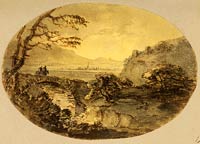
William Gilpin (1724–1804), River-Views, Bays, and Sea Coasts. Album, pen and brown ink, brown and gray-brown wash, over preliminary indications in graphite, on paper washed with ochre, 1781. Purchased as the gift of Mrs. Enid A. Haupt; 1978.39. Repton owed some of his landscaping ideas and the rudiments of his watercolor technique to William Gilpin (1724–1804), author of illustrated travel books extolling the beauties of Picturesque scenery. Gilpin's writings and his innovative aquatint illustrations helped to popularize the Picturesque, an aesthetic based on the fashionable landscape paintings of the day. An Arcadian pastorale by Claude Lorrain or a wilderness scene by Salvator Rosa could provide a frame of reference for viewing nature and a worthy model for garden design. In his own work, Repton sought to achieve a painterly composition of lawn, lake, and trees, but he was also looking after the "comfort and convenience" of his clients. This pragmatic approach harkens back to his illustrious predecessor Lancelot "Capability" Brown (1716–1783), famous for the parks and pleasure grounds he had designed at Stowe, Blenheim, and other grand estates.
Brown's reputation came under attack, however, by proponents of the Picturesque who thought that his style was dull and monotonous in comparison to the enchanting and dramatic landscapes they had learned to appreciate in paintings. They preferred gardens with rustic charm and naturalistic features like brushy woodlands rather than clumps of trees in a placid expanse of lawn. Unfairly, perhaps, they accused Repton of the same stultifying uniformity while also implying that he was so caught up in the routine of his profession that he could not discern the true beauties of the English countryside. They believed that it was better to do it yourself: Instead of hiring outside experts to "torture their estates," country gentlemen should decide on their own how to bring out the best in their parks and pleasure grounds in accordance with the principles of art and the guidance of nature.
Repton responded to their criticisms with his magnificently illustrated Sketches and Hints on Landscape Gardening (1795), along with other publications. The battle lines were drawn, others joined the fray, and some went so far as to question the patriotism of their adversaries. Gracious as always, Repton defended his position during this debate more in sorrow than in anger. He insisted that a garden should be fit for human habitation, a fundamental principle not to be sacrificed to Picturesque effects, although he would be glad to use them in the proper places. Here, for example, is one of his more Picturesque designs rendered in a style similar to the monochrome oval watercolors of Gilpin—as if he were paying tribute to the master.
Plan your visit. 225 Madison Avenue at 36th Street, New York, NY 10016.
Plan your visit. 225 Madison Avenue at 36th Street, New York, NY 10016.
